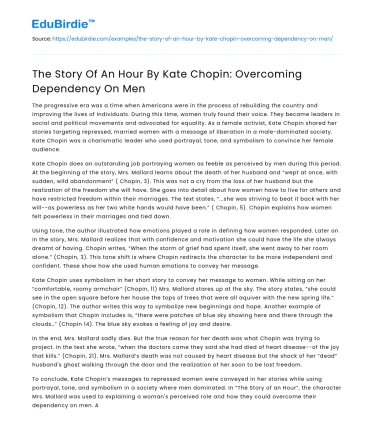The progressive era was a time when Americans were in the process of rebuilding the country and improving the lives of individuals. During this time, women truly found their voice. They became leaders in social and political movements and advocated for equality. As a female activist, Kate Chopin shared her stories targeting repressed, married women with a message of liberation in a male-dominated society. Kate Chopin was a charismatic leader who used portrayal, tone, and symbolism to convince her female audience.
Kate Chopin does an outstanding job portraying women as feeble as perceived by men during this period. At the beginning of the story, Mrs. Mallard learns about the death of her husband and “wept at once, with sudden, wild abandonment” ( Chopin, 3). This was not a cry from the loss of her husband but the realization of the freedom she will have. She goes into detail about how women have to live for others and have restricted freedom within their marriages. The text states, “...she was striving to beat it back with her will--as powerless as her two white hands would have been.” ( Chopin, 5). Chopin explains how women felt powerless in their marriages and tied down.
Save your time!
We can take care of your essay
- Proper editing and formatting
- Free revision, title page, and bibliography
- Flexible prices and money-back guarantee
Using tone, the author illustrated how emotions played a role in defining how women responded. Later on in the story, Mrs. Mallard realizes that with confidence and motivation she could have the life she always dreamt of having. Chopin writes, “When the storm of grief had spent itself, she went away to her room alone.” (Chopin, 3). This tone shift is where Chopin redirects the character to be more independent and confident. These show how she used human emotions to convey her message.
Kate Chopin uses symbolism in her short story to convey her message to women. While sitting on her “comfortable, roomy armchair” (Chopin, 11) Mrs. Mallard stares up at the sky. The story states, “she could see in the open square before her house the tops of trees that were all aquiver with the new spring life.” (Chopin, 12). The author writes this way to symbolize new beginnings and hope. Another example of symbolism that Chopin includes is, “there were patches of blue sky showing here and there through the clouds…” (Chopin 14). The blue sky evokes a feeling of joy and desire.
In the end, Mrs. Mallard sadly dies. But the true reason for her death was what Chopin was trying to project. In the text she wrote, “when the doctors came they said she had died of heart disease--of the joy that kills.” (Chopin, 21). Mrs. Mallard’s death was not caused by heart disease but the shock of her “dead” husband's ghost walking through the door and the realization of her soon to be lost freedom.
To conclude, Kate Chopin’s messages to repressed women were conveyed in her stories while using portrayal, tone, and symbolism in a society where men dominated. In “The Story of an Hour”, the character Mrs. Mallard was used to explaining a woman's perceived role and how they could overcome their dependency on men. According to the author, women are strong and have the same capabilities as men.






 Stuck on your essay?
Stuck on your essay?

